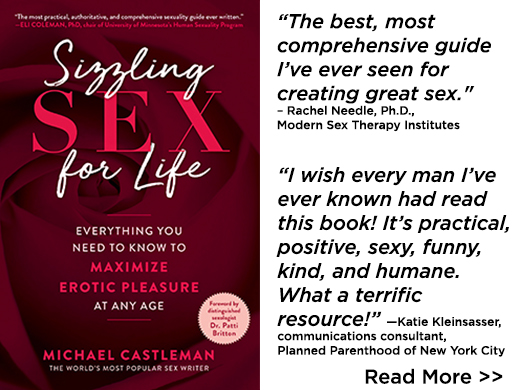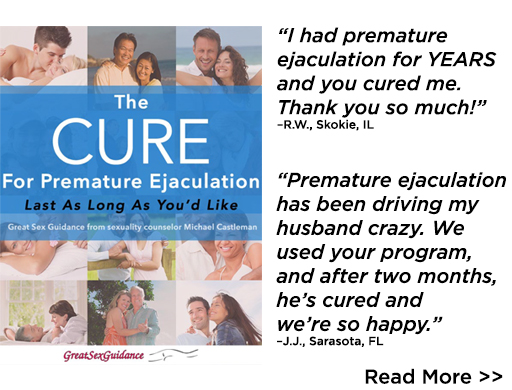
The conventional wisdom is that for both men and women, sexuality is like men’s hair. With age, it recedes and eventually disappears. The conventional wisdom contains a germ of truth. Aging brings sexual changes, frequently including some loss of libido, emphasis on the word “some.” The fact is, for many (most?) people, sexual desire remains a fundamental part of who they are, and the changes that age brings are smaller than most people believe. For some people, older sex represents an improvement over younger sex—bringing more appreciation for sensuality, more emotional intimacy, more sexual satisfaction.
Sex involves a great deal more than youthful exuberance. Some things improve with age, wine, musical instruments—and often lovemaking. Sex after 40 may not feel as urgent or be as athletic as younger sex. But it can feel just as fulfilling—often more so. On the other hand, growing older is also associated with sex problems. Here’s what to expect down the life-long erotic road.
Frequency Declines—But Less Than Most People Think
As part of their landmark 1999 Sex in America survey, University of Chicago researchers asked more than 3,500 men and women aged 18 to 59 about their sexual frequency. The researchers asked: How often have you had partner sex during the last 12 months? The replies:
Men’s Partner Sex Frequency (%)
Women’s Partner Sex Frequency (%)
The numbers differ because, as many studies attest, men and women recall their sex frequency differently. However, the numbers are close enough to provide a reasonably consistent picture of partner sex.
Over the decades, the small proportion of people who are hypersexual, those who have sex four or more times a week, declines considerably, and the one-quarter to one-third of lovers who once enjoyed sex two or three times a week are less likely to maintain that frequency. But from age 18 to 59, the proportion of people making love at least once a week remains fairly consistent and surprisingly high:
Men 18-24: 64%.
Women 18-24: 73%
Men 25-29: 78%
Women 25-29: 85%
Men 30-39: 76%
Women 30-39: 75%
Men 40-49: 73%
Women 40-49: 69%
Men 50-59: 66%
Women 50-59: 49%
After age 50, women’s frequency declines considerably. Many women experience libido loss during the early years of menopause. But later, during late menopause, many women experience a sexual rebound. The main reason postmenopausal women cite for their frequency decline is neither loss of sexual interest nor sex problems, but rather loss of opportunity because of widowhood or the fact that the men in their lives have medical problems that make sex difficult or impossible.
Many People Continue to Have Partner Sex in Their 60s, 70s, and 80s
The 1994 Sex in America study had one glaring defect. The researchers interviewed only adults from 18 to 59. The implication was that there’s no sex after 60. Many sex researchers and advocacy groups for older Americans criticized this myopia. In 2007, another group of University of Chicago researchers (including one of the leaders from the 1994 study) released a new report that surveyed the sex lives of people from 57 to 85.
Respondents who said they’d had partner sex during the previous 12 months:
Sexual frequency declines after 60, but many people in their 70s and 80s continue to enjoy partner sex.
No Less Satisfaction With Age
Does aging mean less sexual satisfaction? Not according to several studies. A 2001 Newsweek survey asked a representative sample of 801 Americans aged 45 to 65: Who has the most enjoyable sex—people your age or younger people? A majority—57 percent of the men and 59 percent of the women—said sex at their age was just as enjoyable as it was when they were younger, or better. British researchers came to same conclusion in a survey that asked 4,000 men and women about their sexual satisfaction. Three-quarters of respondents under 45 said they felt sexually satisfied. For respondents over 65, the figure was identical, 75 percent, with women somewhat more satisfied than men (80 percent vs. 70 percent).
How Women’s and Men’s Sex Problems Change Over the Lifespan
Many researchers have investigated the frequency of sex problems over the lifespan. Unfortunately, their results have been all over the map. Here we focus on the two largest and most comprehensive American sex surveys to date, the University of Chicago study mentioned above, and the National Sexual Health Survey, a 1996 study by researchers at the University of California, San Francisco based on interviews with a representative sample of 8,000 Americans, aged 18 to 80. These surveys explored somewhat different issues, and asked their questions differently. As a result, they came up with different findings. Because of the way these surveys were designed (too complicated to address here), the University of Chicago survey tends to over-estimate the prevalence of sex problems, while the University of California survey tends to underestimate it. The truth probably lies somewhere in between the two sets of results.
According to the Chicago survey, women of all ages are more likely than men to experience sex problems, especially lack of interest in sex, difficulty with orgasm, and discomfort or pain during vaginal intercourse. However, women tend to experience most of their problems before age 30. As the years pass, they become more comfortable with sex, and more assertive about asking for the kinds of caresses and stimulation they need.
In women, the only sex problem that increases with age is vaginal dryness with menopause, a major cause of discomfort during intercourse. Nineteen percent of the youngest women report it, compared with 27 percent of women in their fifties. (This problem can be easily ameliorated with sexual lubricants.) Every other women’s sex problem holds steady or decreases: lack of sexual interest, inability to express orgasm, pain during intercourse, performance anxiety, and lack of pleasure from sex.
Men, on the other hand, experience an increasing prevalence of sex problems with age—notably erectile dysfunction (ED) after age 50. Seven percent of the youngest men report ED, but for men in their fifties, the figure is 18 percent. ED is more treatable than ever with medication. But ironically, most men who use erection drugs do not have ED. They have what sexuality experts are calling “erection dissatisfaction.” Their erections are not as firm as they once were, and they are more likely to subside with minor distractions. In other words, most men who use erection medications take them for erection insurance.
ED is the only men’s sex problem that increases with age. Men’s other problems hold steady or decrease: lack of sexual interest, lack of ejaculatory control, problems expressing orgasm, performance anxiety, and lack of pleasure from sex.
Contrary to conventional wisdom, ED is not older men’s most prevalent sex problem. Rapid, involuntary “premature” ejaculation is. Often considered largely a young men’s problem, involuntary ejaculation remains an issue throughout many men’s lives. At every age, about one-quarter to one-third of men say it’s a problem. Many older men, who learned ejaculatory control in their twenties or thirties, find lack of control returning in their fifties, typically as a result of anxieties around erection. Consciously or subconsciously, they feel that when they have an erection, they should use it—by ejaculating.
The University of California survey agrees that women are more likely than men to experience sex problems. It also agrees that the prevalence of men’s and women’s problems does not change much throughout life, except for an increase in vaginal dryness in women, and increased ED in men. But in the University of California survey, even after 70, only 10 percent of men reported ED half the time or more. Combine these two reports, and the conclusion is inescapable: Aging has some impact on sexuality, but less than most people fear.
A Key Clue to Sexual Vigor after 60
Want to know if you’ll still be doing it after 60? A major clue is how sexual you were during your 40s. If you enjoyed sex regularly in your 40s, chances are you’ll enjoy it after 60—unless you’re faced with illness, divorce, or widowhood.
Sure, sex changes from the teens to the elderly years. But whether you’re enjoying the sexual fireworks of youth or the rich erotic mellowness of sex after 60, lovemaking can feel enjoyable and fulfilling at any age.
References:
Bacon, C. et al. “Sexual Function in Men Older Than 50: Results from the Health Professionals Follow-Up Study,” Annals of Internal Medicine (2003) 139:161.
Beckman, NM and I. Skoog. “Determinants of Sexuality in 70-Year-Olds,” presented at the World Congress of Sexology (2005).
Dunn, KM et al. “Satisfaction in the Sex Live of the General Population,” Journal of Sex and Marital Therapy (2000) 26:141.
Kingsbury, SA. “The Impact of Aging on Sexual Function in Women and their Partners,” Archives of Sexual Behavior (2002) 31:431.
Golden, F. “Still Sexy After 60,” Time 1-19-2004.
Lindau, S.T. et al. “A Study of Sexuality and Health Among Older Adults in the U.S.” New England Journal of Medicine (2007) 357:762.
Panser, LA et al. “Sexual Function Of Men Ages 40 to 79: The Olmstead County Study of Urinary Symptoms and Health Status Among Men,” Journal of the American Geriatric Society (1995) 43:1107.
Reynaert, C. et al. “The ZENITH Sample: Sexual Well-Being Remains Important in the Over-50 Population,” presented at the World Congress of Sexology (2005).
Toner, R. “Majority Over 45 Say Sex Lives Are Just Fine,” New York Times, 8-4-1999.








